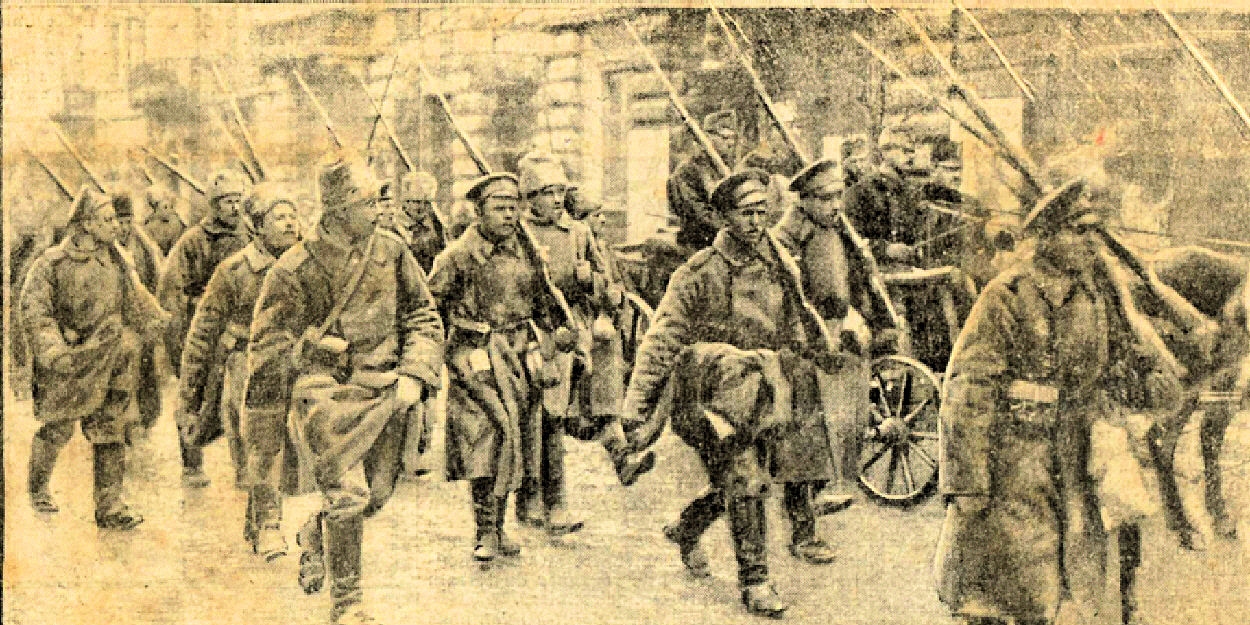 |
| Russian Soldiers on the outskirts of Ternopil |
Katherine Rychly, my aunt was ten years old when World War
One started. The war continued
until 1917, when the Russian Revolution began, and the Russian army retreated
from the Ternopil area and the village of Bila. The end of the war did not bring peace to Galicia, since
various groups occupied the area as a result of wars between the Russians,
Poles and Germans for control of the area. Calm returned in 1920, when Eastern Galicia became part of
Poland. A good part of Katherine’s
early life took place on the front lines of war. She details her life in the village of Bila, just outside
the city of Ternopol, in her memoir/autobiography: Katheryna (Kashka) Autobiography by Katherine Pylatiuk Lymar, as told
to her daughter, Julia, 1988.
Although the Russian Army did not have great success in
World War One, losing battles and territory in Northern Poland; they were very
successful in Galicia. On August 18, 1914, the Russian Eighth army commanded by General
Brusilov, invaded and captured most of Eastern Galicia by the middle of September. The Russians controlled
this area until the end of 1915, when the Austrian-German Army pushed them back to the”Riga-Jakobstadt-Dunaburg-Baranovichi-Pinsk-Dubno-Ternopil”
line. In 1916, the Russian Army retook much of Eastern Galicia, holding it for
several months. The city of Ternopil, and the areas to the east, remained under
Russian control from 1914 until 1917, after the Bolshevik October Revolution.
From that time until the end of the war in 1918, the easternmost areas of
Galicia returned to Austria.
The Russian policy in Galicia was very different than that
of the Austrians. The Austrians
were tolerant of ethnic minority
people, including the Ruthenians (Ukrainians) and Jews. They had some representation in the
government, as well as schools taught in their language and were allowed
religious freedom. For the most part, these groups remained loyal to the
Austrian during the Russian occupation.
Katherine relates a story of how the War affected her
family. Her uncle, Kassian Bryiak, immigrated to Minneapolis in 1913. Nooshka, wife
and son Paul remained in Bila.
The Russians were fighting the Austrians, so this story probably took place
in 1915. The village of
Bila was in their crossfire, the villagers hid in the fields to avoid the
shelling. Nooshka and Paul were
hiding in a hole. Paul was
hungry and started crying, Nooshka decided to go to the barn and get some milk
from a cow. As she entered the
barn, it was hit by a shell, it exploded, killing her and all the animals. According to custom, her body was
washed and dressed and put on a board in her house. Nooska’s father and brother
were sitting next to her body, receiving visitors paying their respects. They decided to go outside for a few minutes to smoke.
As they sat smoking their pipes, a shell came through the window of the
house, exploded in the room where Nooshka was laid out, destroying everything in the room including
her body. What was left of her
remains was buried in the village cemetery. Kassian, her husband, sent money from Minnesota for a stone
memorial, which was unusual, since most village people could afford only wooden
crosses. Not long after it was installed, a shell hit her grave and exploded,
destroyed the gravestone and left a large hole. Village gossip swirled around Nooshka’s unfortunate
end. People in the village said
that she was having an affair with a Russian soldier who often came to the
village. His wife came to see
Nooshka and “put a curse on her”.
The villagers believed that the curse led to her horrible death and the
destruction of her grave.
 |
| Cemetery in Chernobyl, Ukraine, 1998. Photo: David McMillan |
Nooshka’s demise continued to affect Katherine’s
family. The family decided that
her mother, Marya, and her children should move into Nooshka’s house, since it
was much larger and better than theirs. They moved in, but were never
comfortable, because the family found that living there was frightening. When the shell hit the house, Nooshka’s
body was blown to bits, staining the walls and ceiling. Even though it was scrubbed and painted
many times, the stains always reappeared, reminding them of her horrific end.
Katherine experienced the shelling first hand again when she visited her grandmother’s house in the village. A shell landed on the straw roof of her house, but it didn’t explode, and the house wasn’t damaged.
From June of 1915 until 1916, things in Bila were relatively
calm. The Russian soldiers
continued to live in the village houses, but life returned to a sort of
normal. People worked in their
fields and at their trades.
Adjustments were made, since no one knew when the shooting would
start up again.



No comments:
Post a Comment